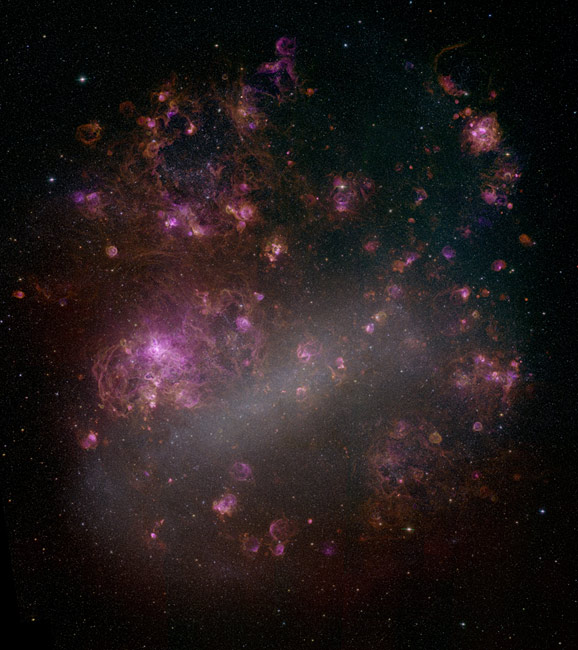Echo of Ancient Cosmic Explosion Seen

Huge explosions on Earth may be one-time deals, but their resounding echoes can give us another bang for our buck if conditions are right.
Strangely,the same is true in the depths of space.
Astronomersrecently captured a supernova's blinding flash "echoing" off dust 400light-years from the detonation site in the Large Magellanic Cloud — whichmeans Earthly observers may have seen the original blast 400 years ago. Becausea star's death rattle produced the light, scientists can use the newobservations to effectively peer into the past.
"Wehave a chance here to see the supernova in both the past and the present,"said Armin Rest, an astronomer at Harvard University who co-authored one of twonew studies on supernovae. "We can see light from the blast bouncing offof dust, and we can also see the supernova remnants. It's kind of like having atime machine."
Rest andother astronomers used NASA's ChandraX-ray observatory, Europe's XMM-Newton observatory and the Gemini observatoryto gather their findings, detailed in two studies in a recent issue of The AstrophysicalJournal.
Blastfrom the past
Supernovaremnant (SNR) 0509-67.5, as the dead star's remains are known, lies about160,000 light-years from Earth — which means the light we see from actually beganits journey 160,000 years ago. The newly observed echo was created in thismanner: Light from the blast traveled for 400 years across the sky, not headingour way, then bounced off stuff and began its journey toward us.
Breaking space news, the latest updates on rocket launches, skywatching events and more!
That means lightfrom the original blast, which headed directly this way, would have reachedEarth 400 years ago. That explosion is no longer observable, but now the echohas been seen.
Rest saidsupernova remnants like SNR 0509-67.5 stick around a long time for astronomersto analyze, but noted it's nearly impossible to see them clearly outside of ourgalaxy. It's also difficult to figure out exactly what kinds of stellarexplosions create remnants.
"Unlessyou record light directly from a supernova when it happens, you get second-handinformation like at a crime scene," Rest said. "Just like it's hardto identify the killer, it's difficult to determine the type of supernovaexplosion."
It'seasiest to catch a supernova under way, he said, but they typically last only afew days.
"We'verecorded only a few supernovae in the past couple of thousand years," Restsaid, noting that telescopes can now efficiently detect new supernovae acrossthe universe, but ancient explosions are trickier to analyze.
Ancientlight
But that'swhere light echoes from violent stellar deaths come in handy, Rest said. Theteams of astronomers monitored the echoing light waves of SNR 0509-67.5 forabout five years to create a time-lapse video of the action.
"Asthe light spreads out from the blast, interstellar gas and dust reflect itaround the universe," he said, comparing it to light reflecting brightlyin fog. "In this case, it took a longer path to get to Earth than thedirect light."
In spite ofits older age, he explained, that reflected light is as good as seeing itdirectly from a supernova.
"Everythingabout the light is preserved, so we can analyze the spectrum and pinpoint thesupernova type, including what kinds of elements it produced," Rest said,noting that carbon, oxygen and heavier atoms necessary for life can be detectedin the light spectra, or signature.
Lightechoes from SNR 0509-67.5 aren'tthe first ever to be seen, but Rest said their importance is growing in thefield.
"Ourability to see light echoes is improving every year now," Rest said,noting advancements in detectors and other telescope technology. "We cancompare these [light echoes] to their supernova remnants and also betterestimate how far away they are. Distance is one of the hardest things todetermine in astronomy."
- SEE THE VIDEO: Echoes of a Supernova Explosion
- Top 10 Star Mysteries
- VIDEO: Supernova: Creator/Destroyer
Dave Mosher is currently a public relations executive at AST SpaceMobile, which aims to bring mobile broadband internet access to the half of humanity that currently lacks it. Before joining AST SpaceMobile, he was a senior correspondent at Insider and the online director at Popular Science. He has written for several news outlets in addition to Live Science and Space.com, including: Wired.com, National Geographic News, Scientific American, Simons Foundation and Discover Magazine.
